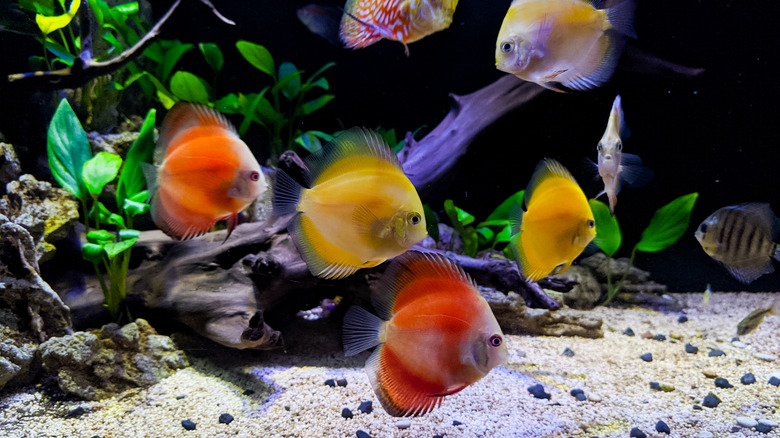How Much Gravel For A 30-Gallon Fish Tank?
You might regard the gravel on the bottom of the tank as a decorative element for your tank, but for many types of fish and aquarium creatures, it is crucial to everyday life. Gravel also provides a home for beneficial bacteria that help break down nitrates in your tank. The amount of gravel or freshwater aquarium sand you should use as substrate depends on the type of fish you have, the type of gravel you choose, and the measurements of your aquarium.
Gravel for 30-gallon fish tank
Gravel for 30-gallon fish tank
The rule of thumb for buying gravel for your aquarium is 1 pound of regular aquarium gravel per 1 gallon of water. That means you should plan on a minimum of 30 pounds for a 30-gallon tank for each 1.25 inches of substrate.
However, you might need more depending on the length and width of the aquarium bottom across which you'll be spreading the gravel and the depth of substrate you desire. You'll also want deeper substrate if your fish like to dig burrows or nests in gravel, like cichlids do, or comb through the substrate for bits of food, like catfish do.
Deeper gravel is useful for securing the roots of live plants. Sword plants are named for their pointed leaves that branch out from the plant's base in a rosette fashion, creating ideal hiding places for fry and other fish. Because they can grow to nearly 2 feet tall, they must be able to securely anchor their roots deep into the substrate. Use about 4 inches of gravel in your 30-gallon aquarium to provide an adequate foundation for them.
Do the math
Do the math
You can calculate the amount needed for the exact measurements of your aquarium. First, use a tape measure to determine the length of your tank. A standard 30-gallon tank is 36 by 13 by 16 inches, and you'd find that you'd need 46.8 pounds of substrate using this method. However, you'll find tanks ranging from 29 to 32 gallons in many shapes and lengths, so be sure to measure exactly.
Longer aquariums with a height of 12 inches are generally used for cichlids or other fish who need more room to swim. Short aquariums with tall sides are generally used as breeding tanks, as fish will hang close to their nest. Energetic mating swims could cause some fish to jump out of a tank; higher sides help prevent that.
Multiply the length of your aquarium in inches times the width. Divide the answer by 10 and you'll arrive at how many pounds are needed. Alternatively, use an aquarium substrate calculator.
Freshwater aquarium sand and gravel
Freshwater aquarium sand and gravel
Your calculations could be different should you choose a different type of substrate for your aquarium. For planted aquariums, you'll want to use pea gravel rather than large gravel to let plants get well anchored into the substrate. Make sure to get well-rounded gravel when you have fish who like to move around gravel with their mouth, such as cichlids.
Cories, on the other hand, should have a substrate of freshwater aquarium sand to protect their delicate barbells from getting bruised or inflamed or even falling off. A standard 30-gallon aquarium will require 52 to 75 pounds of sand depending on the size and type of sand you choose. Consult with a fish store expert or do research before picking out sand or another substrate, as it will affect bacteria levels, water pH, and even the health of your fish.
References
- Aquarium Sphere: How Much Gravel Does an Aquarium Need?
- Modern Aquarium: Swords
- The Pet Supply Guy: Fish Tank Gravel Calculator
- Aqua-Calc: Compute Weight of Gravel in a Rectangular Aquarium
- The Aquarium Guide: Best Aquarium Sand in 2021
- Fishkeeping Forever: Is Gravel Ok for Corydora Catfish? (Sand or Gravel)
- HugglePets: How to Calculate Your Fish Tank Gravel
